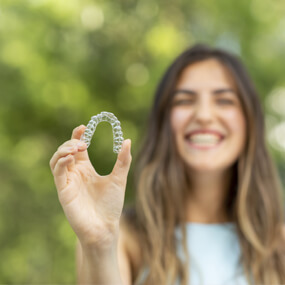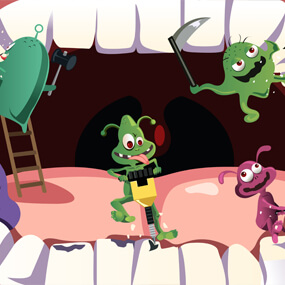Freshen Your Breath With a Do-It-Yourself Oral Rinse

Mouthwash is not a modern invention. Humans have been freshening their breath with oral rinses for ages, and some of the earliest written recipes for mouthwash date back to 2700 B.C.
Even Hippocrates—the Father of Medicine—had a recipe to combat halitosis: alum, salt, and vinegar. The upper class of the ancient Greek and Roman civilizations would rinse with such mixtures after brushing their teeth with chew sticks, which were made from branches or reeds. The indigenous people of the Americas were known to soak various plants in water to fight infections and for fresh breath.
The commercialization of mouthwash is rather modern, however, and there were only about a dozen or so brands sold over the counter in the United States by 1970. Now, the U.S. market boasts more than 100 unique brands, and most of those companies have several or more distinct products.
An oral rinse can be an important part of your oral hygiene regimen. But OTC mouthwashes can be abrasive. These products often contain alcohol that dries out the mouth and can actually exacerbate bad breath. They can also contain ingredients like thymol, which is used as an additive in cigarettes, can be harmful to humans in large doses, and is known to be bad for aquatic life and the environment in general.
The alternative is to make your own mouthwash, which may seem strange to the modern person used to meeting all of their oral hygiene needs at the local grocery or pharmacy. But making your own can be less expensive and give you greater control of what goes in it, and the rinse can be more effective too.
What Should Using Mouthwash Achieve?
This depends on the user and what that person seeks to achieve. The basic oral rinse is intended to eliminate bad breath and make the mouth feel clean and fresh. But there are also mouthwashes that contain fluoride to strengthen tooth enamel and fight cavities. There are products that can help maintain white teeth, and other products are formulated to fight plaque, tartar, and gum disease.
Is Using an Oral Rinse Effective?
This answer depends on your goals. A mouthwash can be either cosmetic or therapeutic, and consider that in the American Dental Association’s oral hygiene recommendations, it specifies therapeutic. Cosmetic rinses give you the sensation of feeling fresh and may even alleviate bad breath for a time, but those effects are transitory. If you enjoy good oral health, that may be enough for you.
Therapeutic mouthwashes, on the other hand, contain ingredients intended to provide a long-term benefit. Fluoride can strengthen teeth and help you avoid cavities. Peroxide helps whiten teeth, and chlorhexidine is an antimicrobial that helps to avoid and combat gingivitis and periodontitis.
The ADA does not necessarily recommend all therapeutic mouthwashes for daily use. A fluoridated rinse is generally fine for regular use. A rinse with chlorhexidine, however, should only be used as needed, and a rinse with a teeth whitener should only be used on occasion to help maintain white teeth.
Avoid Mouthwashes That Contain Alcohol
Be mindful that using mouthwash is not necessarily necessary. Note that while the ADA advises you to brush twice a day and floss daily, it only advises that you can optionally use a therapeutic rinse. Alcohol was, at one point, the primary commercial mouthwash ingredient, and it is still prevalent today, but the ADA is careful not to recommend it.
Regular use of alcohol in this manner is not good for your mouth because it dries out the mucous membranes. It actually makes people more prone to cavities as well as dry mouth, and while it can mask bad breath temporarily, the drying of the mouth can make the bad breath worse when it returns. Some research even suggests a link between alcohol used in this manner and oral cancer.
Advantages of Making Your Own Mouthwash
Optimal oral hygiene benefits your overall health, and positive systemic health is good for your teeth and gums. Consider that a healthy person can even reverse cavities and gingivitis with good oral care. Making your own oral rinse can aid in that effort. DIY mouthwash:
- Is cheap. You can make your own rinse for a fraction of what OTC products costs, and with the ingredients on hand, you can make it as you need it, which allows it to be fresher.
- Allows you to control the ingredients. You know exactly what you are putting in your mouth, and you do not have to worry about allergies and other negative reactions.
- Does not need dyes, sweeteners, preservatives, and so forth. If you knew every ingredient that goes into some of the top brands, you would be horrified and never use them again!
With homemade mouthwash, you can make it and use it as you need it, such as to:
- Get ready for a date
- Make your mouth feel fresh
- Neutralize the acids in your mouth
- Comfort a sore throat
- Soothe oral discomfort
Let us consider some of the ingredients you can use in a homemade oral rinse:
- Salt – Salt has been used for its medicinal properties for thousands of years. Mixing salt with warm water is among the oldest, simplest and effective mouthwashes, and it can serve as an excellent ingredient in more complex rinses too. Consider that dentists often recommend salt water rinses after surgery because it not only disinfects but soothes and promotes healing by reducing inflammation. Salt water can also make the mouth more alkaline, which can be helpful after acidic meals and snacks. It has also been suggested that using a natural salt can aid in remineralizing your teeth. Another advantage is that salt serves as a natural preservative and can make a batch of homemade mouthwash last longer.
- Baking Soda – Baking soda is a popular ingredient in oral care products, and you can use it at home. Not only does baking soda neutralize acids in your mouth, but it is also an excellent cleaning agent as well as a deodorizer. The ADA recommends the regular use of baking soda orally to control bacteria that can lead to tooth decay and gum disease. It is an excellent option after an acidic meal or beverage, and the National Cancer Institute advises a baking soda rinse to offset the oral side effects sometimes caused by chemotherapy.
- Xylitol – Xylitol is a sugar-free sweetener that occurs naturally in many fruits and vegetables. It is a popular ingredient in sugar-free gum, and what makes it appealing from an oral care perspective is that it disrupts the formation of plaque as well as the process of plaque hardening into calculus. Pet parents should note, however, that xylitol is toxic to dogs and should be stored with care.
- Essential Oil – An essential oil is a hydrophobic—meaning it is repelled from water—liquid that contains plant compounds. Such oils have been used in holistic medicine for thousands of years. Potential health benefits aside, these oils can add flavor to your DIY rinse and freshen your breath.
Which Essential Oils Should You Use?
There are many essential oils on the market, and it really comes down to preference. You should, however, avoid acidic essential oils, and since all of these oils are barely soluble, and you will probably not use an agent to keep the rinse mixed, you will have to mix well prior to each use. With that in mind, let us consider some of the most popular essential oil options for homemade mouthwash.
- Peppermint Oil – Peppermint oil is likely the most popular option. Not only do most people love the taste and scent, but it is readily available at local groceries and pharmacies. Peppermint also contains menthol, which gives you the sensation of feeling cooler, thus gives that cool, fresh feel people like from their mouthwashes.
- Wintergreen Oil – Wintergreen oil is quite similar in that regard. It may be even better to offset bad breath, and it can help alleviate inflammation and discomfort due to oral infections. Be mindful that wintergreen is toxic in high quantities, so just a drop or two will do, and make sure to spit it out after you finish rinsing.
- Tea Tree Oil – Many people do not care for the taste of this oil, but it is an antimicrobial and so can kill bacteria and even help with gingivitis and oral candidiasis. You can mix tea tree oil with an essential oil that has a better and stronger taste. Mix the oils first. Then, add that mixture to the water.
- Lemongrass Oil – Lemongrass oil is another popular option. Many people like the taste, and it is not as strong as peppermint or wintergreen. This oil has been found to be an antibacterial that helps combat tooth decay and gum disease, so you will often see it recommended as a natural oral care option.
- Clove oil – Clove has been used for its medicinal properties and in a wide range of ways for thousands of years. Clove oil is both an anti-inflammatory and analgesic. It is effective as a sore throat reliever and can be used for mouth ulcers as well as toothaches prior to seeing your dentist. Consider that an aspect of this oil— zinc oxide-eugenol—is used to make a cement that dentists employ as a temporary filling.
Ensure Fresh Breath and Excellent Oral Health
Homemade mouthwash can be a great way to bolster your oral hygiene routine, but be mindful that it is no substitute for brushing your teeth twice a day, flossing daily, and visiting your dentist every six months. If you have any questions about what you should and should not mix into your do-it-yourself oral rinse, or other questions involving wellness dentistry, be sure to ask your dentist. Jeffrey D. Clark, DDS, would be glad to answer those questions. You can schedule your appointment with Dr. Clark at Scottsdale Cosmetic Dentistry Excellence by calling us at 480 585 1853.




